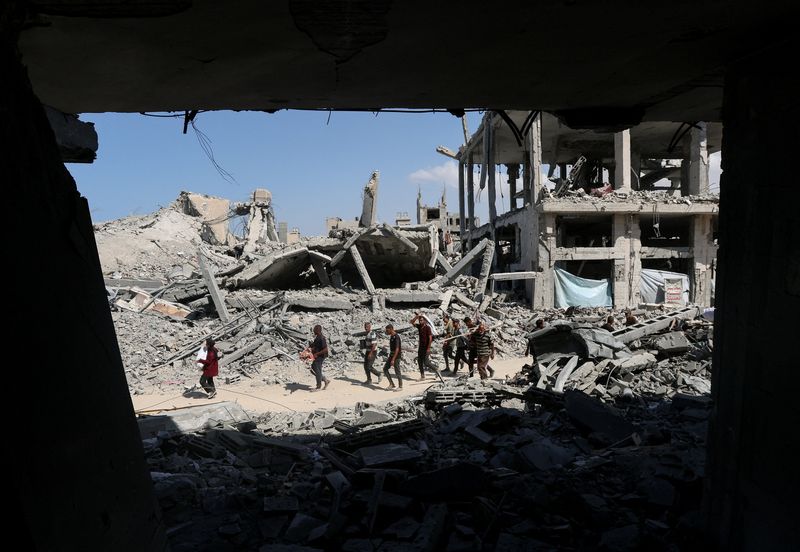By Nidal al-Mughrabi
CAIRO/GAZA (Reuters) -As thousands of Gazans began picking through the ruins of their shattered homes on Friday after a ceasefire deal, the excitement of return was quickly tempered by shock at the depth of the destruction and anxiety over the hardships ahead.
The announcement that the U.S.-brokered accord had gone into effect sent thousands of Palestinians pouring up the Gaza Strip’s coastal road by foot, bicycle, truck and donkey cart toward the largely devastated north.
Essentially all of Gaza’s 2.2 million population was displaced during two years of unrelenting war that has killed tens of thousands of people and reduced huge swathes of the enclave to ruins.
For some, the prospect of returning even to the remnants of their former houses was enough to inspire elation.
“Of course, there are no homes – they’ve been destroyed – but we are happy just to return to where our homes were, even over the rubble,” Mahdi Saqla, 40, said as he stood by a makeshift tent in central Gaza. “That, too, is a great joy.”
Trudging along the road along with her family, former Gaza City resident Mahira al-Ashi said she was so excited to return to the city where she’d grown up that she couldn’t sleep as she waited for news about when they could start moving.
“By God, when they opened the road, I was so happy to go back,” she said.
CONFRONTING STARK REALITY
But for many of those who have already returned, the stark reality of the situation quickly sank in.
To the south, in the city of Khan Younis, Ahmed al-Brim pushed a bicycle loaded with wood through a scene of apocalyptic destruction – row after row of buildings crumpled by bombardment and streets strewn with rubble.
“We went to our area – it was exterminated,” he said, waving a hand through the air. “We don’t know where we will go after that.”
Another Khan Younis resident, Muhannad al-Shawaf, said it used to take him three minutes to reach a nearby street from his house. Now, took over an hour as he picked his way through piles of debris.
“The destruction is huge and indescribable – indescribable,” he said. “It is almost all in ruins and not suitable for living in.”
LITTLE LEFT OF OLD LIVES
Despite the widespread celebrations that greeted news of the ceasefire, many Palestinians were keenly aware even before going back that little remained of the lives they knew before the war.
“Okay, it is over – then what? There is no home I can go back to,” Balqees, a mother of five from Gaza City who has been sheltering in Deir al-Balah in central Gaza, told Reuters on Friday morning.
“They have destroyed everything. Tens of thousands of people are dead, the Gaza Strip is in ruins, and they made a ceasefire. Am I supposed to be happy? No, I am not.”
Her sentiments were echoed by Mustafa Ibrahim, an activist and human rights advocate from Gaza City who also took refuge in Deir al-Balah, one of the few areas in the enclave not overrun and levelled by Israeli forces.
“Laughter has vanished and tears have run dry,” he said. “The people of Gaza are lost, as if they are the walking dead, searching for a distant future.”
‘ENTIRE DISTRICTS ARE GONE’
Some former Gaza City residents had already started heading back even before the ceasefire went into effect, some making it as far as the northwest suburb of Sheikh Radwan.
Among them was Ismail Zayda, a 40-year-old father of three, who went to check on his house on Friday morning and was amazed to find it still intact – albeit amid a “sea of rubble”.
“Thank God, my house is still standing,” he told Reuters in a voice note. “But the area is destroyed, my neighbours’ houses are destroyed – entire districts are gone.”
The war erupted in October 2023 after Hamas-led militants stormed into Israel and killed around 1,200 people and took 251 hostages.
Israel’s retaliatory air and ground war killed over 67,000 people, according to local health officials, reduced much of the coastal Gaza Strip to vast tracts of rubble and wrought a humanitarian disaster.
(Writing by Alex Dziadosz; editing by Mark Heinrich)

